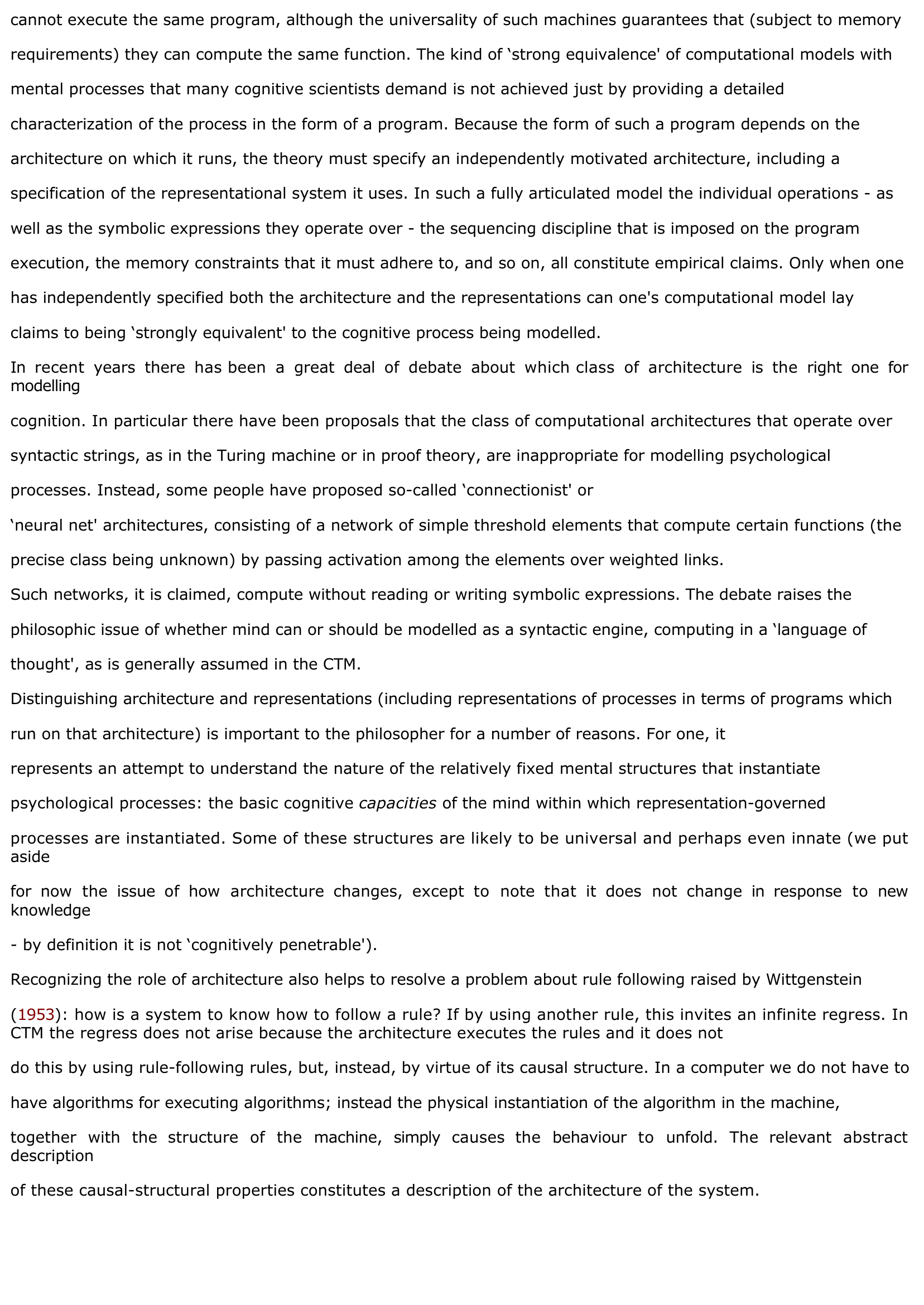Cognitive architecture
Publié le 22/02/2012

Extrait du document


«
cannot execute the same program, although the universality of such machines guarantees that (subject to memory
requirements) they can compute the same function.
The kind of ‘strong equivalence' of computational models with
mental processes that many cognitive scientists demand is not achieved just by providing a detailed
characterization of the process in the form of a program.
Because the form of such a program depends on the
architecture on which it runs, the theory must specify an independently motivated architecture, including a
specification of the representational system it uses.
In such a fully articulated model the individual operations - as
well as the symbolic expressions they operate over - the sequencing discipline that is imposed on the program
execution, the memory constraints that it must adhere to, and so on, all constitute empirical claims.
Only when one
has independently specified both the architecture and the representations can one's computational model lay
claims to being ‘strongly equivalent' to the cognitive process being modelled.
In recent years there has been a great deal of debate about which class of architecture is the right one formodelling
cognition.
In particular there have been proposals that the class of computational architectures that operate over
syntactic strings, as in the Turing machine or in proof theory, are inappropriate for modelling psychological
processes.
Instead, some people have proposed so-called ‘connectionist' or
‘neural net' architectures, consisting of a network of simple threshold elements that compute certain functions (the
precise class being unknown) by passing activation among the elements over weighted links.
Such networks, it is claimed, compute without reading or writing symbolic expressions.
The debate raises the
philosophic issue of whether mind can or should be modelled as a syntactic engine, computing in a ‘language of
thought', as is generally assumed in the CTM.
Distinguishing architecture and representations (including representations of processes in terms of programs which
run on that architecture) is important to the philosopher for a number of reasons.
For one, it
represents an attempt to understand the nature of the relatively fixed mental structures that instantiate
psychological processes: the basic cognitive capacities of the mind within which representation-governed
processes are instantiated.
Some of these structures are likely to be universal and perhaps even innate (we putaside
for now the issue of how architecture changes, except to note that it does not change in response to newknowledge
- by definition it is not ‘cognitively penetrable').
Recognizing the role of architecture also helps to resolve a problem about rule following raised by Wittgenstein
(1953 ): how is a system to know how to follow a rule? If by using another rule, this invites an infinite regress.
In CTM the regress does not arise because the architecture executes the rules and it does not
do this by using rule-following rules, but, instead, by virtue of its causal structure.
In a computer we do not have to
have algorithms for executing algorithms; instead the physical instantiation of the algorithm in the machine,
together with the structure of the machine, simply causes the behaviour to unfold.
The relevant abstractdescription
of these causal-structural properties constitutes a description of the architecture of the system..
»
↓↓↓ APERÇU DU DOCUMENT ↓↓↓
Liens utiles
- Peut-on considérer l’architecture écologique comme élément clé permettant l’optimisation de la qualité de vie dans les villes ?
- Quel est la place des mathématiques dans l’architecture ?
- ARCHITECTURE CIVILE BASÉE SUR LA GÉOMÉTRIE ET RAPPORTÉE A LA PERSPECTIVE (L') de Ferdinando Galli Bibiena (résumé & analyse)
- ARCHITECTURE LOMBARDE (L') (résumé & analyse) d’Arthur Kingsley Porter
- VERS UNE ARCHITECTURE. Le Corbusier (résumé)

































